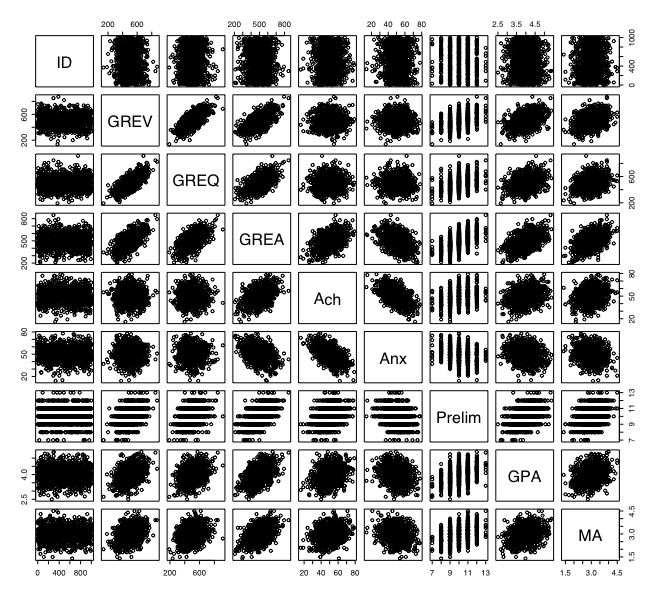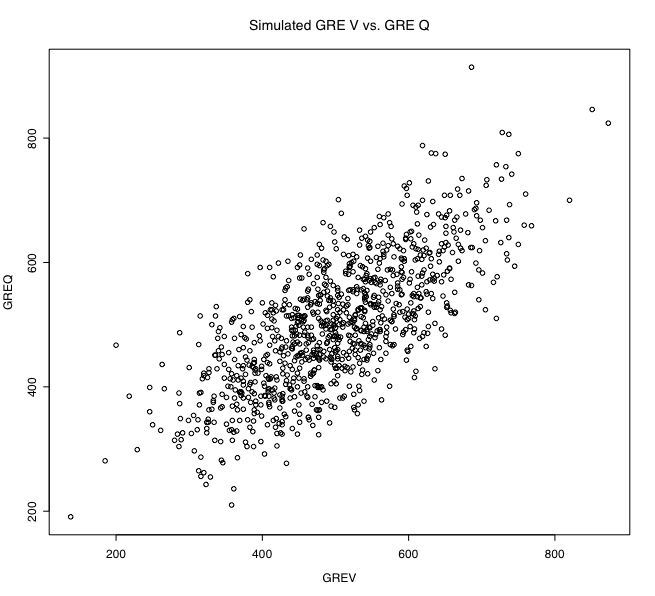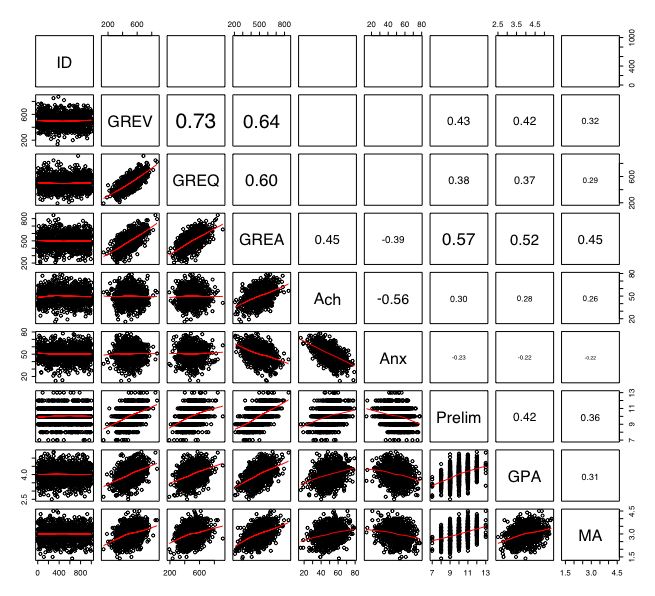pairs(dataset)
produces this output

datafilename="http://personality-project.org/R/datasets/psychometrics.prob2.txt" dataset =read.table(datafilename,header=TRUE) #read the data fileGet the data set and find the basic descriptive statistics. Then plot GREV versus GREQ against each other.
Find the correlation matrix of all of the variables in the data set.
Show the scatter plot of two variables.
summary(dataset)
ID GREV GREQ GREA
Min. : 1.0 Min. :138.0 Min. :191.0 Min. :207.0
1st Qu.: 250.8 1st Qu.:427.0 1st Qu.:428.0 1st Qu.:431.8
Median : 500.5 Median :497.5 Median :498.0 Median :495.0
Mean : 500.5 Mean :499.8 Mean :500.5 Mean :498.1
3rd Qu.: 750.2 3rd Qu.:570.2 3rd Qu.:571.0 3rd Qu.:569.0
Max. :1000.0 Max. :873.0 Max. :914.0 Max. :848.0
Ach Anx Prelim GPA
Min. :16.00 Min. :14.00 Min. : 7.00 Min. :2.500
1st Qu.:43.00 1st Qu.:44.00 1st Qu.: 9.00 1st Qu.:3.640
Median :50.00 Median :50.00 Median :10.00 Median :4.020
Mean :49.93 Mean :50.32 Mean :10.03 Mean :4.003
3rd Qu.:56.00 3rd Qu.:57.00 3rd Qu.:11.00 3rd Qu.:4.360
Max. :79.00 Max. :78.00 Max. :13.00 Max. :5.380
MA
Min. :1.400
1st Qu.:2.700
Median :3.000
Mean :2.996
3rd Qu.:3.300
Max. :4.500
Problem 2: Find the correlation matrix for these cases.
Although the basic command cor(dataset) will do what we want, a more useful call is to round these results to two decimals.
round(cor(dataset),2)
produces this output.
> round(cor(dataset),2)
ID GREV GREQ GREA Ach Anx Prelim GPA MA
ID 1.00 -0.01 0.00 -0.01 0.00 -0.01 0.02 0.00 -0.01
GREV -0.01 1.00 0.73 0.64 0.01 0.01 0.43 0.42 0.32
GREQ 0.00 0.73 1.00 0.60 0.01 0.01 0.38 0.37 0.29
GREA -0.01 0.64 0.60 1.00 0.45 -0.39 0.57 0.52 0.45
Ach 0.00 0.01 0.01 0.45 1.00 -0.56 0.30 0.28 0.26
Anx -0.01 0.01 0.01 -0.39 -0.56 1.00 -0.23 -0.22 -0.22
Prelim 0.02 0.43 0.38 0.57 0.30 -0.23 1.00 0.42 0.36
GPA 0.00 0.42 0.37 0.52 0.28 -0.22 0.42 1.00 0.31
MA -0.01 0.32 0.29 0.45 0.26 -0.22 0.36 0.31 1.00
To show the scatter plot of the GREV and GREQ, use the plot() function.

Perhaps more useful is to do this for all the pairs of variables. This may be done as a SPLOM (scatter plot matrix) using the pairs() command.
pairs(dataset)
produces this output

Using a bit more code, it is possible to combine the correlation matrix with the SPLOM
#first, we create a new function (taken from the example for pairs)
panel.cor <- function(x, y, digits=2, prefix="", cex.cor)
{
usr <- par("usr"); on.exit(par(usr))
par(usr = c(0, 1, 0, 1))
r = (cor(x, y,use="pairwise"))
txt <- format(c(r, 0.123456789), digits=digits)[1]
txt <- paste(prefix, txt, sep="")
if(missing(cex.cor)) cex <- 0.8/strwidth(txt)
text(0.5, 0.5, txt, cex = cex * abs(r))
}
# now use the function for the data. (see figure)
#do the following one at at time
pairs(dataset, lower.panel=panel.smooth, upper.panel=panel.cor)
